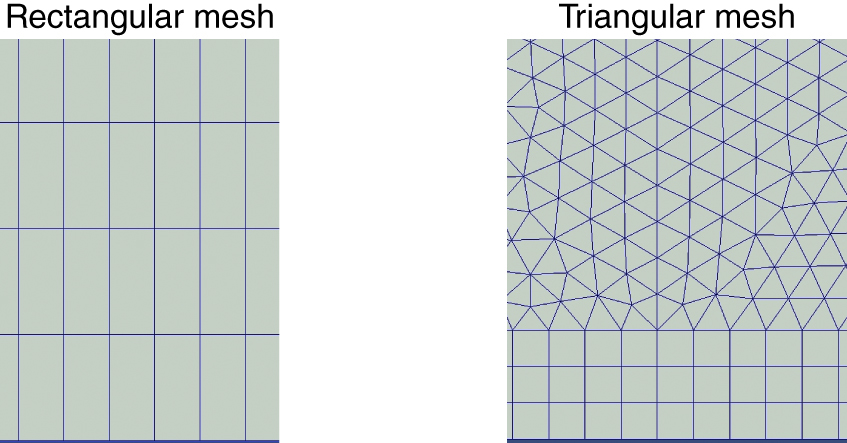
Fig.2-3 Schematic sketch of meshes

Fig.2-4 The simulation using the CFD code OpenFOAM
In nuclear power plant accidents, a chemical reaction between fuel rod cladding and water leads to the generation of hydrogen gas. Hydrogen combustion may occur when hydrogen leaks into a containment vessel (CV) or a reactor building and reacts with oxygen. Therefore, accurately estimating hydrogen-gas behavior during accidents is important for securing reactor safety. Detailed analysis with computational fluid dynamics (CFD) should be performed to clarify multi-dimensional flow in CVs or reactor buildings having a large volume. The influence of buoyancy should be considered while evaluating hydrogen gas behavior because the gas is very light. In CFD simulations, a simulation area is generally divided into a small rectangular or triangular mesh. The triangular mesh is often applied to complex geometries such as CVs. However, previous researchers have indicated that the calculation accuracy with a triangular mesh is low when simulating buoyant flows.
In this research, we discuss the application of triangular meshes to a simulation of buoyant flows. The flows are analyzed by injecting hot fluid from the bottom of the 2D area while filled with cold fluid. As shown in Fig.2-3, the triangular and rectangular meshes were applied to the simulations using the CFD code OpenFOAM.
Fig.2-4 (a) shows the numerical result of temperature using the rectangular mesh with the existing solver implemented in the OpenFOAM code. This numerical result was confirmed to be a valid symmetrical distribution, which is very similar to that obtained with the fine mesh. Fig.2-4 (b) shows the asymmetrical distribution using the triangular mesh. The calculation accuracy is low for the gradient term due to the large non-orthogonality of the triangular mesh, which may cause differences between the symmetrical and asymmetrical distributions. Fig.2-4 (c) shows the symmetrical distribution obtained by the triangular mesh and a non-orthogonal (NO) correction. This correction is used to mitigate the influence of the mesh non-orthogonality. Fig.2-4 (d) shows the result obtained with the triangular mesh and the NO correction using the solver modified by JAEA. The modified solver could mitigate the influence of the mesh non-orthogonality, and calculations made with this solver were faster. We proposed a numerical method for the fast simulation of buoyant flows with the triangular mesh. In the future, we will conduct CFD analysis for complex geometries such as CVs with the application of our simulation method.